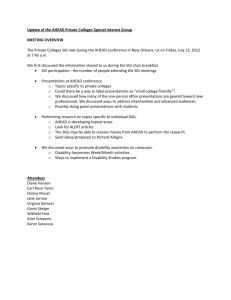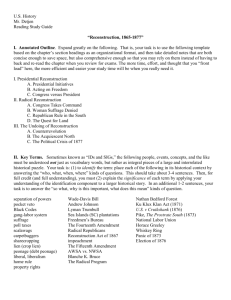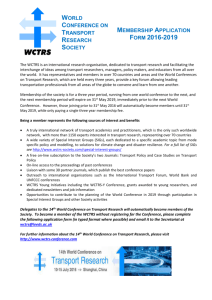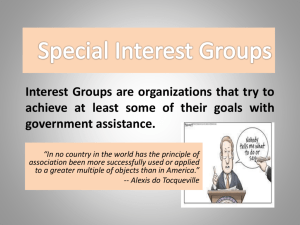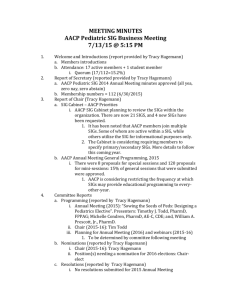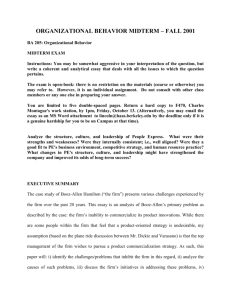Interest Groups - Southwest High School
advertisement
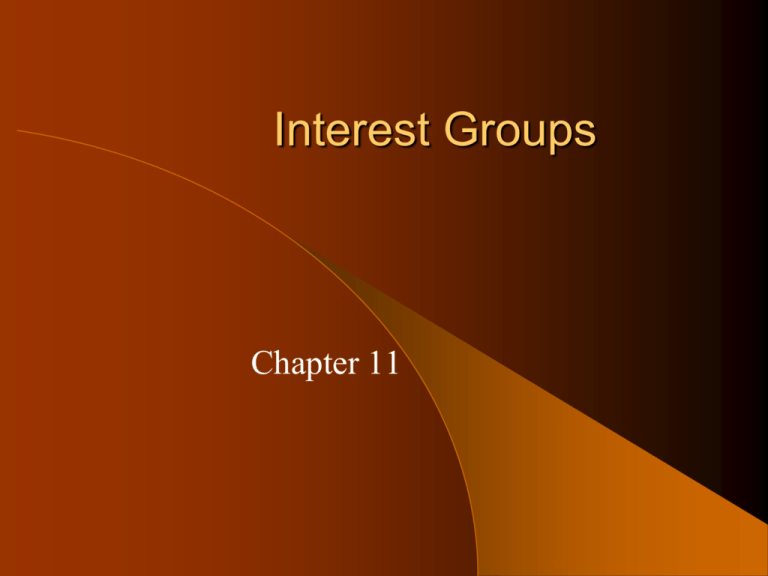
Interest Groups Chapter 11 Key Definitions What is a special interest group? – Organization of people with similar policy goals who enter the political process to try and achieve those aims BUT don’t run their own candidates for office – Operate at every level of government in the federal government. Key Linkage Institutions People Political Parties Media SIGS Government Key Linkage Institutions People Political Parties Media SIGS Government Test Tip The mass media, political parties, and interest groups are key linkage institutions. Be sure you can identify these linkage institutions. Be sure you can explain the ways that they connect citizens to the government. SIGS as a Linkage Institution 1. 2. 3. 4. SIGS express their members’ preferences to government policy makers. SIGS convey government policy information to their members. Interest groups raise and spend money to influence policymakers. SIGS form PACS to funnel money to candidates for winning elections SIGS as a Linkage Institution SIGS 1. Seek to support officials and influence policy. 2. Focus on specific issues that affect their membership. As a result, SIGS articulate specific policy positions. 3. Private organizations accountable to members Political Parties 1. Nominate candidates, contest elections, seek to gain control of government. 2. Have positions on wide range of public issues. 3. Public organizations accountable to voters TYPES OF SIGS Fortune Magazine 2001 Types of SIGS Officials in the legislative and executive branches of the federal government control the distribution of billions of dollars. As a result, most industries, corporations, professions and unions have SIGS representing them in Washington D.C. The number of SIGS has increased from 6,000 in 1959 to approximately 22,000 in 2010. Types of SIGS: Business Groups National Association of Manufactures represents 12,000 small and large manufactures in every industrial sector and all 50 states. NAM focuses on legislation affecting labor laws, minimum wages, corporate taxes, and trade regulations. Types of SIGS: Business Groups Chamber of Commerce is the world’s largest business federation. Spends $20 million a year lobbying for 3000 local chambers and 3 million members. Types of SIGS: Business Groups The Business Roundtable is an association of about 150 CEOs of leading US corporations with $5 trillion in annual revenues and nearly 10 million employees. Types of SIGS: Labor The American labor movement reached its peak in 1956 when 33% of the nonagricultural work force belonged to unions. Today, 16 million Americans, or about 13% belong to a union. Types of SIGS: Labor The AFL-CIO is the largest labor union both in size and political power. About 10 million workers are members of unions belonging to the AFL-CIO Types of SIGS: Agriculture Although farmers comprise less that 2% of the population, their interest groups play an influential role. The Farm Bureau and the National Farmers Union are broad-based organizations that speak for farmers. Types of SIGS: Agriculture Specialized SIGS represent different farm products. National Milk Producers Federation Types of SIGS: Professional Associations The National Education Association (NEA) represents 3.2 million public school teachers, support staff and retired educators. Types of SIGS: Professional Associations The American Medical Association (AMA) is the largest association of doctors and medical students. Types of SIGS: Professional Associations The American Bar Association (ABA) is an association of over 410,000 lawyers and law students. Types of SIGS: Environmental Groups Leading environmental groups include the Sierra Club, the Audubon Society and the World Wildlife Fund. Environmental SIGS support wilderness protection, pollution control, and animal rights. They generally oppose strip mining, nuclear power plants and offshore drilling. Types of SIGS: Public Interest Groups Over 2,000 groups champion causes that promote the public good. Leading groups include Common Cause and the League of Women Voters. Types of SIGS: Public Interest Groups “Unsafe at any Speed” National Traffic and Motor Vehicle Safety Act. – National Highway Traffic Safety Administration Shift in responsibility for auto safety from the consumer to the manufacturer. – Seat belts Types of SIGS: Equality Interests The National Association for the Advancement of Colored People (NAACP) is one of the oldest advocacy civil rights groups. The National Organization for Women is the largest group dedicated to women's’ issues. Types of SIGS: Single-Issue Groups These groups focus all their efforts on one issue. For example, the National Right to Life Committee opposes legal abortion while NARAL lobbies for legal abortion. The National Rifle Association is one of the best known influential single issue groups. GOALS AND STRATEGIES SIGS: Goals Fundamental Goals 1. Gain access to policymakers 2. Influence public policy 3. Support sympathetic policymakers SIGS: Strategies -- Lobbying Lobbying: the process by which SIGS attempt to influence the decisions of policymakers. – Important sources of information – Help with strategy to pass legislation – Help with campaign strategy and motivate members to get involved – Source of ideas and innovation Does it work? SIGS: Strategies -- Lobbying Lobbying Congress – 30,000 lobbyists spend over $2 billion – Testify in congressional committees – Provide information to members of Congress – Meet with congressional aides – Bring influential constituents to Washington to meet with members of Congress SIGS: Strategies -- Lobbying “The better lobbyists, when they have a proposal they are pushing, bring it to me along with a couple of speeches, a Record insert, and a fact sheet.” SIGS: Strategies -- Lobbying Lobbying the Executive Branch – Most executive lobbying focuses on presenting a point of view to White House aides and other government officials. – SIGS direct particular attention to regulatory agencies. SIGS: Strategies -- Lobbying Lobbying the courts (litigation) – Inappropriate to meet with members of the courts. – SIGS can and do take their issues to the courts if they fail in the legislative and executive branches. (Think Brown v. Board of Education) Amicus curiae briefs (someone, not a party to a case, who volunteers to offer information to assist a court in deciding a matter before it) Play a role in nominations to the courts. Test Tip There has been at least one MCQ about PACs on every released exam. It is very important that you understand the function and impact of PACs. SIGS: Strategies – Contributing Money (electioneering) SIGS form PACs to raise money and make contributions to candidates they support. PAC contributions are regulated. (currently $5000 per candidate per election) Over 4,600 registered PACs. Over half are sponsored by business groups and corporations. Play a significant role in supporting incumbent members of the HOR. SIGS: Strategies – Contributing Money (electioneering) 527’s are another way that SIGS use money to achieve their goals. 527’s (named for the section of the law in which they were created) can raise unlimited amounts of unregulated money and use it for voter mobilization, issue advocacy, but NOT for candidate advocacy or to be given to candidates These are independent expenditures. Think Swift Boat for Veterans for Truth and MoveOn.Org The Senate: Lawyers, Drugs, and Money SECTOR | # OF MEMBERS Finance, insurance, and real estate 57 Lawyers and lobbyists 25 Health 5 Agribusiness 3 Labor 2 Energy and natural resources 2 Miscellaneous business 2 Communications and electronics 1 No money raised 3 Total seats | 100 Donations by Industry, 1989-2010 Top corporate donors in the '08 presidential race. Obama Goldman Sachs $994,795 2. Microsoft $833,617 3. Google $803,436 4. Citigroup $701,290 5. JPMorgan Chase $695,132 6. Time Warner $590,084 7. Sidley Austin $588,598 8. National Amusements $551,683 9. UBS $543,219 10. WilmerHale $542,618 1. McCain Merrill Lynch $373,595 2. Citigroup $322,051 3. Morgan Stanley $273,452 4. Goldman Sachs $230,095 5. JPMorgan Chase $228,107 6. AT&T $201,438 7. Wachovia $195,063 8. UBS $192,493 9. Credit Suisse $183,353 10. PricewaterhouseCoopers $167,900 1. SIGS: Strategies – Shape Public Opinion Going Public SIGS undertake expensive public relations campaigns to bring an issue to the public. SIGS use advertising to promote their image. SIGS may engage in highly visible protest demonstrations. – Business groups rarely use this tactic. SIGS: Strategies 1. Lobbying 1. Congress, presidency, courts (litigation) and bureaucracy 2. Contributing money to candidates (electioneering) 1. PACs, and 527’s 3. Shape public opinion – Going Public WHAT MAKES A SIG SUCCESSFUL? What makes a SIG successful? SIZE – Size can be an important asset. – NOT ALWAYS What makes a SIG successful? “pressure politics is essentially the politics of small groups.” – E.E. Schattschneider Pressure politics: political action which relies heavily on the use of mass media and mass communications to persuade politicians that the public wants or demands a particular action. Think prohibition. What makes a SIG successful? Potential group: all the people that could join. Actual group: people that actually join Collective Good: something all share, even the potential members Collective Good What makes a SIG successful? Free-rider Problem – Why should a potential member join a group, pay dues and do the work if they can enjoy the collective good without becoming an actual member? What makes a SIG successful? Olson’s laws of large groups – “the larger the group, the further it will fall short of providing an optimal amount of a collective good.” – The bigger the group, the larger the problem – Smaller groups have an organizational advantage over larger groups. – Explains why smaller groups are often more successful than larger groups. What makes a SIG successful? How can large groups overcome this disadvantage? – Offer selective – benefits. – Selective benefits are only for actual members—those who join the group. AARP Consumers Union What makes a SIG successful? Intensity – Groups that have passionately committed activists tend to be more successful than those groups whose members are less intensely involved. – Because of their narrow focus, single-issue groups are able to mobilize intensely committed members. What makes a SIG successful? Financial Resources – All SIGS need money to hire lobbyists, support PACs, write amicus curie briefs etc… – Big money can compensate for lack of size and intensity. – Wealthier groups have more money, but do not always get what they want. What makes a SIG successful? 1. 2. 3. Size Intensity Financial Resources INTEREST GROUP THEORY Test Tip Be sure that you can compare and contrast elite, pluralist and hyperpluralist theories of how the system works. All three theories attempt to explain who has power and influence in the U.S. Interest Group Theory Pluralist Theory 2. Elite Theory 3. Hyperpluralist Theory 1. Interest Group Theory Pluralist Theory – Many SIGS compete for power. – Public policy is the result of the negotiating, compromising and bargaining among competing groups – Because of federalism and the three branches there are many points of access and influence and no one group can dominate. – Groups lacking money can use their size and intensity to achieve their goals. Interest Group Theory Elite Theory – A small number of wealthy individuals, powerful corporate interests and large financial institutions dominate. – PACs encourage a close connection between money and politics. – “Citizens with lower or moderate incomes speak with a whisper that is lost on the ears of inattentive government officials, while the advantages roar with a clarity and consistency that policymakers readily hear and routinely follow.” Interest Group Theory Hyperpluralist theory – Too many SIGS trying to influence policy. – When political leaders try to appease competing groups they often create policies that are confusing and sometime contradictory. – Example: tobacco Iron Triangle Subgovernments Interest Group Liberalism Term used by political scientists to describe the policy-making relationship between the legislature, the bureaucracy and SIGS An example of such an iron triangle would be the American Association for Retired People (AARP), the Senate Special Committee on Aging, and the Social Security Administration all working together to set government policy on Social Security. Another example is Congress (House and Senate Committees on Armed Services), defense contractors, and the U.S. Department of Defense forming the iron triangle and working together to set defense policy and budgets. A final example is in agriculture. Agribusinesses, like ADM, ethanol producers and ConAgra are SIGS that seek to benefit from agricultural policies such as subsidies. The U.S. Department of Agriculture (USDA) services these constituencies. Senators and representatives wield enormous power, and are unlikely to win elections in agriculture-driven regions if they oppose these policies. This results in certain agricultural products (like corn) being subsidized by taxpayers. Interest Group Theory Pluralist Theory Elite Theory Hyperpluralist theory – Issue networks, Subgovernments, Iron triangles, Interest group liberalism Regulation of SIGS Lobbyists/SIGS must register Two-year cooling off period Limitations on gifts and contributions Disclosure of issues and bills Limits and disclosure on PACs Limits on independent expenditures Regulation of SIGS: PACs and 527s Lobbyists/SIGS must register Two-year cooling off period Limitations on gifts and contributions Disclosure of issues and bills Understanding Interest Groups Interest Groups and Democracy – James Madison’s solution to the problems posed by interest groups was to create a wide-open system in which groups compete. – Pluralists believe that the public interest would prevail from this competition. – Elite theorists point to the proliferation of business PACs as evidence of interest group corruption. – Hyperpluralists maintain that group influence has led to policy gridlock. Understanding Interest Groups Interest Groups & the Scope of Government – Interest groups seek to maintain policies and programs that benefit them and… …Interest groups continue to pressure government to do more things, thus …As the government does more, does this cause the formation of more groups? Summary SIG theories: – pluralism, elitism, and hyperpluralism A number of factors influence a group’s success. Interest groups affect policy process through lobbying, electioneering, litigation, and going public.

